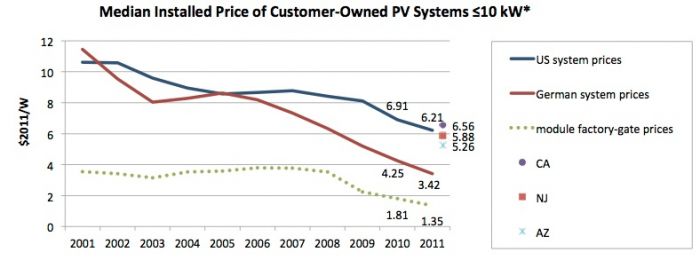Why is residential solar so much cheaper in Germany? Hint: It’s not just speed
 In a follow-up to a 2012 study conducted by the Lawrence Berkeley National Laboratory (LBL), researchers found that the average number of man-hours to install a PV system on a residence in Germany is 39. That’s a significant difference from the 7.5 man-hours LBL’s researchers found when they surveyed German PV installers in Sep. 2012, yet the cost difference remains the same, leaving us to wonder why it’s so much cheaper there (roughly $3.42 per installed watt at the end of 2011) compared to the U.S. (roughly $6.21 per installed watt at the end of 2011).
In a follow-up to a 2012 study conducted by the Lawrence Berkeley National Laboratory (LBL), researchers found that the average number of man-hours to install a PV system on a residence in Germany is 39. That’s a significant difference from the 7.5 man-hours LBL’s researchers found when they surveyed German PV installers in Sep. 2012, yet the cost difference remains the same, leaving us to wonder why it’s so much cheaper there (roughly $3.42 per installed watt at the end of 2011) compared to the U.S. (roughly $6.21 per installed watt at the end of 2011).
The LBL found that the main difference in cost between the two countries is in the so-called soft-costs of solar. Soft costs include legal, permitting and other non-system costs related to installing a PV system. “Total soft costs for residential PV in Germany, including margin, are just 19 percent of the implied soft costs for U.S. residential PV ($0.62/W vs. $3.34/W),” according to the new version of the study.
The roughly $2.70 per watt difference in soft costs—as of the end of 2011, was attributable to a number of factors within the larger umbrella of soft costs. The majority of lowered costs about $1.32 per watt in Germany were related to overhead, profit and residual soft costs. Other cost reductions stemmed from the lower customer acquisition costs (ads, etc.) of 7 cents per watt—that’s about 62 cents less per watt than installers spend per customer in the U.S. And, despite lower wage costs in the U.S. , the cost of labor on German residential PV installations was 36 cents per watt lower than in the U.S. Germany also doesn’t have any sales or value-added tax, reducing costs by 21 cents per installed watt, and similar amount is reduced because Germany doesn’t have any permitting fees.
In the revised study, LBL found some additional reasons for the lower costs in Germany, including shorter project development times and, because Germany’s solar resources are less than in the U.S., homes need larger arrays, allow access to greater economies of scale. And the market in Germany is more homogenous, meaning that it’s not fractured by 50 states, and thousands of local regulations.
These costs are just related to the soft costs of solar in the U.S. and Germany, modules also cost less in Germany, largely because of the higher adoption and more stable market for solar there. The study recommended taking a number of policy steps in the U.S. to bring the costs down. Such steps include creating a concentrated market, a simple incentive structure and a simple process for interconnection, permitting and inspection. LBL will host a Webcast on Feb. 26 to discuss the study and its findings.



